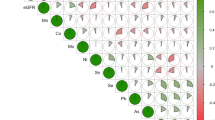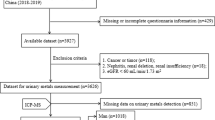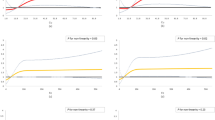Abstract
The association between co-exposure to multiple metals and renal function is poorly understood. We aimed to evaluate the individual and joint effects of metal exposure on renal function in this study. We performed a cross-sectional study including 5828 participants in Guangxi, China, in 2019. Urine concentrations of 17 metals were detected by inductively coupled plasma mass spectrometry (ICP-MS). Logistic regression model and restricted cubic spline (RCS) were applied to investigate the association of individual metal exposure with renal dysfunction. Weighted quantile sum (WQS) regression and Bayesian kernel machine regression (BKMR) were used to assess the co-exposure effects of the metals. Participants with the highest quartile of urinary Cu were at 1.84-fold (95% confidence interval (CI): 1.20–2.87) increased risk of renal dysfunction compared with the lowest quartile. The highest quartiles of urinary Sr, Cs, V, Ba, and Se were associated with 0.27-fold (95% CI: 0.17–0.43), 0.33 (95% CI: 0.19–0.53), 0.41 (95% CI: 0.25–0.65), 0.58 (95% CI: 0.36–0.90), and 0.33 (95% CI: 0.19–0.56) decreased risk of renal dysfunction compared with their lowest quartile, respectively. Furthermore, urinary Ba and Cu were non-linearly correlated with renal dysfunction. The WQS analysis showed that mixed metal exposure was inversely associated with renal dysfunction (OR = 0.47, 95% CI: 0.35–0.62), and Sr accounted for the largest weight (52.2%), followed by Cs (32.3%) in the association. Moreover, we observed a potential interaction between Cu, Cs, and Ba for renal dysfunction in BKMR model. Exposure to Se, Sr, Cs, V, and Ba is associated with decreased risk of renal dysfunction, whereas an increased risk is associated with Cu exposure. Co-exposure to these metals is negatively associated with renal dysfunction, and Sr and Cs are the main contributors to the associations.





Similar content being viewed by others
Data availability
The data that support the findings of this study are available from the corresponding author upon reasonable request.
Abbreviations
- ICP-MS:
-
inductively coupled plasma mass spectrometry
- LASSO:
-
least absolute shrinkage and selection operator
- RCS:
-
restricted cubic spline
- WQS:
-
weighted quantile sum
- BKMR:
-
bayesian kernel machine regression
- CKD:
-
chronic kidney disease
- GFR:
-
glomerular filtration rate
- MDRD:
-
modification of diet in renal disease
- SCr:
-
serum creatinine
- LOD:
-
limits of detection
- Tl:
-
thallium
- Rb:
-
rubidium
- Mo:
-
molybdenum
- Ti:
-
titanium
- Sn:
-
stannum
- Cr:
-
chromium
- Ni:
-
nickel
- Pb:
-
plumbum
- Se:
-
selenium
- Sr:
-
strontium
- Cs:
-
cesium
- Cu:
-
copper
- V:
-
vanadium
- Ba:
-
barium
- Mn:
-
manganese
- As:
-
arsenic
- Sb:
-
stibium
- BMI:
-
body mass index
- groupPIP:
-
group posterior inclusion probability
- condPIP:
-
conditional posterior inclusion probability
References
Ashrap P, Sánchez BN, Téllez-Rojo MM, Basu N, Tamayo-Ortiz M, Peterson KE, Meeker JD, Watkins DJ (2019) In utero and peripubertal metals exposure in relation to reproductive hormones and sexual maturation and progression among girls in Mexico City. Environ Res 177:108630
Bello AK, Nwankwo E, El Nahas AM (2005) Prevention of chronic kidney disease: a global challenge. Kidney Int 68(Supplement):S11–S17
Bobb JF, Valeri L, Claus Henn B, Christiani DC, Wright RO, Mazumdar M, Godleski JJ, Coull BA (2015) Bayesian kernel machine regression for estimating the health effects of multi-pollutant mixtures. Biostatistics (Oxford, England) 16:493–508
Bobb JF, Claus Henn B, Valeri L, Coull BA (2018) Statistical software for analyzing the health effects of multiple concurrent exposures via Bayesian kernel machine regression. Environ Health : A global access science source 17:67
Boulassel B, Sadeg N, Roussel O, Perrin M, Belhadj-Tahar H (2011) Fatal poisoning by vanadium. Forensic Sci Int 206:79–81
Carrico C, Gennings C, Wheeler DC, Factor-Litvak P (2015) Characterization of weighted quantile sum regression for highly correlated data in a risk analysis setting. J Agric Biol Environ Stat 20:100–120
Coker E, Chevrier J, Rauch S, Bradman A, Obida M, Crause M, Bornman R, Eskenazi B (2018) Association between prenatal exposure to multiple insecticides and child body weight and body composition in the VHEMBE South African birth cohort. Environ Int 113:122–132
Crowe E, Halpin D, Stevens P (2008) Early identification and management of chronic kidney disease: summary of NICE guidance. BMJ (Clinical research ed) 337:a1530
Cui X, Okayasu R (2008) Arsenic accumulation, elimination, and interaction with copper, zinc and manganese in liver and kidney of rats. Food Chem Toxicol : An Int J Publ Br Ind Biol Res Assoc 46:3646–3650
Czarnota J, Gennings C, Wheeler DC (2015) Assessment of weighted quantile sum regression for modeling chemical mixtures and cancer risk. Cancer Informat 14:159–171
Diamond GL, Thayer WC, Brown JS, Burgess M, Follansbee MH, Gaines LGT, Klotzbach JM (2019) Estimates of urinary blood lead clearance and its relationship to glomerular filtration rate based on a large population survey. J Toxicol Environ Health Part A 82:379–382
El-Boshy ME, Risha EF, Abdelhamid FM, Mubarak MS, Hadda TB (2015) Protective effects of selenium against cadmium induced hematological disturbances, immunosuppressive, oxidative stress and hepatorenal damage in rats. J Trace Elements Med Biol : Organ Soc Min Trace Elements (GMS) 29:104–110
Fair PH, Dougherty WJ, Braddon SA (1985) Methyl mercury and selenium interaction in relation to mouse kidney gamma-glutamyltranspeptidase, ultrastructure, and function. Toxicol Appl Pharmacol 80:78–96
Fairweather-Tait SJ, Bao Y, Broadley MR, Collings R, Ford D, Hesketh JE, Hurst R (2011) Selenium in human health and disease. Antioxid Redox Signal 14:1337–1383
Hardy G, Hardy I, Manzanares W (2012) Selenium supplementation in the critically ill. Nutr Clin Pract : Off Publ Am Soc Parent Enteral Nutr 27:21–33
Ingsathit A, Thakkinstian A, Chaiprasert A, Sangthawan P, Gojaseni P, Kiattisunthorn K, Ongaiyooth L, Vanavanan S, Sirivongs D, Thirakhupt P, Mittal B, Singh AK (2010) Prevalence and risk factors of chronic kidney disease in the Thai adult population: Thai SEEK study. Nephrol Dialysis, Transplant : Official Publ Eur Dialysis Transplant Assoc - Europ Renal Association 25:1567–1575
Jin R, Zhu X, Shrubsole MJ, Yu C, Xia Z, Dai Q (2018) Associations of renal function with urinary excretion of metals: Evidence from NHANES 2003-2012. Environ Int 121:1355–1362
Kim NH, Hyun YY, Lee KB, Chang Y, Ryu S, Oh KH, Ahn C (2015) Environmental heavy metal exposure and chronic kidney disease in the general population. J Korean Med Sci 30:272–277
Kumar V, Kalita J, Misra UK, Bora HK (2015) A study of dose response and organ susceptibility of copper toxicity in a rat model. J Trace Elements Med Biol : Organ Soc Min Trace Elements (GMS) 29:269–274
Kumar V, Kalita J, Bora HK, Misra UK (2016) Relationship of antioxidant and oxidative stress markers in different organs following copper toxicity in a rat model. Toxicol Appl Pharmacol 293:37–43
Lei R, Wu C, Yang B, Ma H, Shi C, Wang Q, Wang Q, Yuan Y, Liao M (2008) Integrated metabolomic analysis of the nano-sized copper particle-induced hepatotoxicity and nephrotoxicity in rats: a rapid in vivo screening method for nanotoxicity. Toxicol Appl Pharmacol 232:292–301
Levey AS, Atkins R, Coresh J, Cohen EP, Collins AJ, Eckardt KU, Nahas ME, Jaber BL, Jadoul M, Levin A, Powe NR, Rossert J, Wheeler DC, Lameire N, Eknoyan G (2007) Chronic kidney disease as a global public health problem: approaches and initiatives - a position statement from Kidney Disease Improving Global Outcomes. Kidney Int 72:247–259
Lister LJ, Svendsen C, Wright J, Hooper HL, Spurgeon DJ (2011) Modelling the joint effects of a metal and a pesticide on reproduction and toxicokinetics in Lumbricid earthworms. Environ Int 37:663–670
Liu Y, Yuan Y, Xiao Y, Li Y, Yu Y, Mo T, Jiang H, Li X, Yang H, Xu C, He M, Guo H, Pan A, Wu T (2020) Associations of plasma metal concentrations with the decline in kidney function: a longitudinal study of Chinese adults. Ecotoxicol Environ Saf 189:110006
Liu Y, Dong R, Yang Y, Xie H, Huang Y, Chen X, Wang D, Zhang Z (2021) Protective effect of organic selenium on oxidative damage and inflammatory reaction of rabbit kidney induced by T-2 toxin. Biol Trace Elem Res 199:1833–1842
Ma YC, Zuo L, Chen JH, Luo Q, Yu XQ, Li Y, Xu JS, Huang SM, Wang LN, Huang W, Wang M, Xu GB, Wang HY (2006) Modified glomerular filtration rate estimating equation for Chinese patients with chronic kidney disease. J Am Soc Nephrol : JASN 17:2937–2944
Melnikov P, Zanoni LZ (2010) Clinical effects of cesium intake. Biol Trace Elem Res 135:1–9
Nugent RA, Fathima SF, Feigl AB, Chyung D (2011) The burden of chronic kidney disease on developing nations: a 21st century challenge in global health. Nephron Clin Pract 118:c269–c277
Oste L, Bervoets AR, Behets GJ, Dams G, Marijnissen RL, Geryl H, Lamberts LV, Verberckmoes SC, Van Hoof VO, De Broe ME, D'Haese PC (2005) Time-evolution and reversibility of strontium-induced osteomalacia in chronic renal failure rats. Kidney Int 67:920–930
Pors Nielsen S (2004) The biological role of strontium. Bone 35:583–588
Rahman HH, Niemann D, Munson-McGee SH (2021) Association of albumin to creatinine ratio with urinary arsenic and metal exposure: evidence from NHANES 2015-2016. Int Urol Nephrol 54:1343–1353
Sanders AP, Mazzella MJ, Malin AJ, Hair GM, Busgang SA, Saland JM, Curtin P (2019) Combined exposure to lead, cadmium, mercury, and arsenic and kidney health in adolescents age 12-19 in NHANES 2009-2014. Environ Int 131:104993
Skröder H, Hawkesworth S, Kippler M, El Arifeen S, Wagatsuma Y, Moore SE, Vahter M (2015) Kidney function and blood pressure in preschool-aged children exposed to cadmium and arsenic--potential alleviation by selenium. Environ Res 140:205–213
Tsai HJ, Hung CH, Wang CW, Tu HP, Li CH, Tsai CC, Lin WY, Chen SC, Kuo CH (2021) Associations among heavy metals and proteinuria and chronic kidney disease. Diagnostics (Basel, Switzerland), Basel, p 11
Valdivielso JM, Jacobs-Cachá C, Soler MJ (2019) Sex hormones and their influence on chronic kidney disease. Curr Opin Nephrol Hypertens 28:1–9
Wang X et al (2020) Exposure to multiple metals in early pregnancy and gestational diabetes mellitus: a prospective cohort study. Environ Int 135:105370
Wanigasuriya KP, Peiris-John RJ, Wickremasinghe R (2011) Chronic kidney disease of unknown aetiology in Sri Lanka: is cadmium a likely cause? BMC Nephrol 12:32
Weaver VM, Kotchmar DJ, Fadrowski JJ, Silbergeld EK (2016) Challenges for environmental epidemiology research: are biomarker concentrations altered by kidney function or urine concentration adjustment? J Exposure Sci Environ Epidemiol 26:1–8
Wu W, Zhang K, Jiang S, Liu D, Zhou H, Zhong R, Zeng Q, Cheng L, Miao X, Tong Y, Lu Q (2018) Association of co-exposure to heavy metals with renal function in a hypertensive population. Environ Int 112:198–206
Yang F, Yi X, Guo J, Xu S, Xiao Y, Huang X, Duan Y, Luo D, Xiao S, Huang Z, Yuan H, He M, Shen M, Chen X (2019) Association of plasma and urine metals levels with kidney function: a population-based cross-sectional study in China. Chemosphere 226:321–328
Zhang L et al (2012) Prevalence of chronic kidney disease in China: a cross-sectional survey. Lancet (London, England) 379:815–822
Zhang Y, Dong T, Hu W, Wang X, Xu B, Lin Z, Hofer T, Stefanoff P, Chen Y, Wang X, Xia Y (2019) Association between exposure to a mixture of phenols, pesticides, and phthalates and obesity: Comparison of three statistical models. Environ Int 123:325–336
Acknowledgements
The authors acknowledge all participants and all staff for their supports and cooperation in this study. We also thank the Guangxi Colleges and Universities Key Laboratory of Prevention and Control of Highly Prevalent Diseases, and Academician Dongxin Lin workstation for providing a good experimental environment.
Funding
This work was funded by National Key Research and Development Program of China (2017YFC09071030).
Author information
Authors and Affiliations
Contributions
Xingxi Luo: conceptualization, formal analysis, methodology, writing-original draft, investigation. Dongping Huang: methodology, writing-original draft, formal analysis, investigation, data curation. Suyang Xiao: methodology, validation, investigation, data curation. Lei Lei: methodology, writing-review & editing. Kaili Wu: formal analysis, validation. Yu Yang: investigation, data curation. Meiliang Liu: data curation. Xiaoqiang Qiu: methodology, funding acquisition. Shun Liu: conceptualization, methodology, resources, writing-review & editing, supervision. Xiaoyun Zeng: conceptualization, methodology, resources, data curation, writing-review & editing, supervision, funding acquisition.
Corresponding author
Ethics declarations
Ethics approval
This study was approved by the Ethics Review Committee of Guangxi Medical University.
Consent to participate
Before examinations, all that participated in present study provided written informed consent.
Consent for publication
All of co-authors agreed that the article will be published in Environmental Science and Pollution Research.
Competing interests
The authors declare no competing interests.
Additional information
Responsible Editor: Lotfi Aleya
Publisher’s note
Springer Nature remains neutral with regard to jurisdictional claims in published maps and institutional affiliations.
Supplementary Information
ESM 1
(DOCX 612 kb)
Rights and permissions
Springer Nature or its licensor holds exclusive rights to this article under a publishing agreement with the author(s) or other rightsholder(s); author self-archiving of the accepted manuscript version of this article is solely governed by the terms of such publishing agreement and applicable law.
About this article
Cite this article
Luo, X., Huang, D., Xiao, S. et al. Associations between co-exposure to multiple metals and renal function: a cross-sectional study in Guangxi, China. Environ Sci Pollut Res 30, 2637–2648 (2023). https://doi.org/10.1007/s11356-022-22352-x
Received:
Accepted:
Published:
Issue Date:
DOI: https://doi.org/10.1007/s11356-022-22352-x




